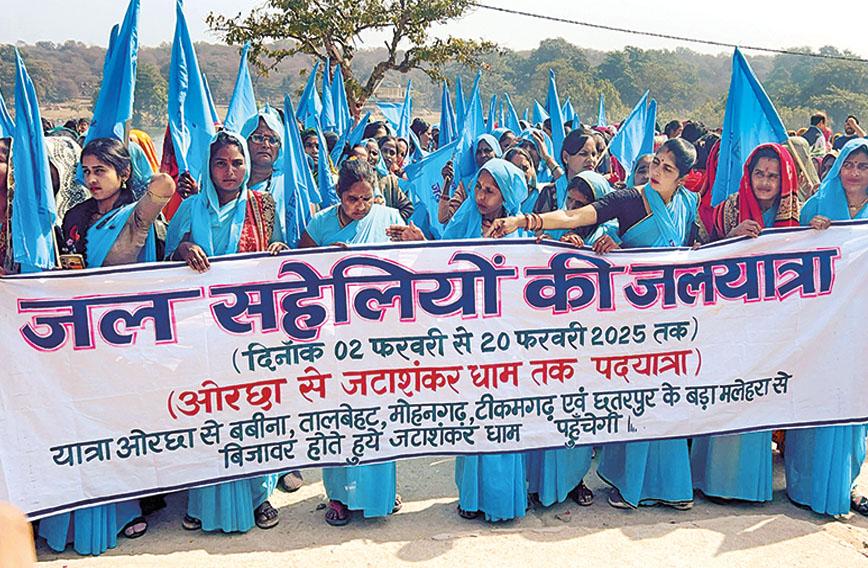
Jal sahelis in Bundelkhand
Water in village taps
GOVERNMENT officials have been working hard to speed up pipelines and provide taps in all villages. However, in nearly a dozen villages that I visited recently in various states, people still face water scarcity because water sources being tapped for pipelines are themselves getting depleted. The problem will worsen as summer peaks.
The most important lesson to be learnt from the past is that water conservation must get much more importance than it has received. The rate at which a very large number of ponds, tanks and other waterbodies have been depleted, encroached upon and vanished is deeply worrying. Alongside, many rich traditions of water conservation are being eroded rapidly, despite the fact that these traditions represent the best methods of conserving water in keeping with local conditions. Much can still be learnt from them for cost-effective and sustainable solutions.
Mega projects involving large dams and transfer of water over very long distances come with several adverse social and environmental impacts, displacement being only one of them. Such expensive projects take away a huge part of the water budget. Very little is saved for the thousands of small projects that rural communities need for conserving rainwater and taking forward important aspects of proper water management.
The best policy for any rural community is to conserve rainwater as much as possible using methods most suited to local conditions. Water can then be used in disciplined ways so that actual use is not more than what is locally available. This is the most sustainable path to water security.
How can every village or cluster of villages practise such jal swaraj?
First, local communities should be strengthened so that they can take decisions on the best way of ensuring water security and self-reliance at the local level. They must be able to access a reasonable budget for this. Within the community the voice of weaker sections and of women must get adequate attention. There should be a spirit of voluntarism to take up community work or contribute to it. And an understanding of traditional wisdom on the best methods of conserving rainwater and managing water as well as water sources. Of course, new ideas are always welcome; it is only ecosystem disrupting projects and schemes that should be avoided. There should be community discipline so that water is not wasted. And there should be community strength to prevent outsiders from misusing water and harming basic water sources like rivers and ponds.
Many rural communities are not empowered to take such decisions. Rivers and sometimes even village tanks are harmed by outside forces. Villages find themselves powerless. Sand mining and pollution destroy local rivers. Water is overused by powerful vested interests beyond the carrying capacity of the water source.
On the other hand, if rural communities are given the task of managing water, then chances of this vital resource being used in a sustainable and equitable manner are bright. Water budgets and plans are then likely to reflect the needs of rural communities. Governments will not need to resort to water transfers across vast regions. Raising the water table and better adaptation to climate change can be achieved.
Several such initiatives for moving in the direction of jal swaraj are taking place in various parts of the country. But progress, at times, cannot go beyond a certain stage due to constraints of the existing systems.
One effort that has received much appreciation in recent years is the well-known initiative of jal sahelis or women water volunteers in rural areas of Bundelkhand region. They have been involved in restoration of many ponds and even rejuvenation of some small rivers. Early this year there was a further boost to such efforts. A 300-km foot march was organized in which nearly 300 jal sahelis participated. This helped raise the collective strength of the water volunteers. They started going beyond merely village-level initiatives and asked for policy changes that would be more supportive of community-based water initiatives.
Parmarth, a voluntary organization, started this important initiative. With the help of jal sahelis it has drawn up a charter of demands. The jal sahelis and Parmarth members have been meeting various authorities and decision-takers so that several demands which emerged in the course of the yatra can be taken further.
These include preparing a working plan for the restoration of traditional water sources particularly ponds and tanks, setting up a centre for restoring these tanks and a centre for jal sahelis, making the implementation of the Atal groundwater scheme more participative and creating more space for community participation in plans for water and soil conservation works.
Also included are demands to prioritize the rejuvenation, protection and cleaning of several small rivers. Planting of trees, particularly in the catchment areas of rivers and other water sources, and raising more community nutrition gardens has also been sought.
At several points in the yatra, participants along with local villagers took pledges to work for the protection of rivers, tanks and other water sources they encountered on their way which were found to be suffering from serious problems and threats.
The participants carried a kalash or traditional water utensil with drops of water from all these sources along the yatra to create an emotional bond of protection for these water sources.
As details of what needs to be done to protect these water sources have been collected in the course of the march there is now a major opportunity for speeding up this work and doing it in better ways.
Contact with a lot of local people devoted to taking up such work has also been established. The government should also utilize the opportunities that have been created by this yatra and efforts for speeding up protective work relating to these water sources.
The writer is Honorary Convener, Campaign to Save Earth Now. His recent books include Protecting Earth for Children and Planet in Peril.
Comments
Currently there are no Comments. Be first to write a comment!





